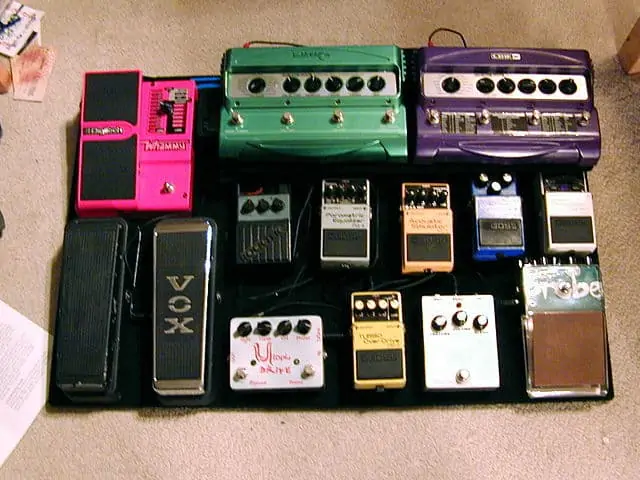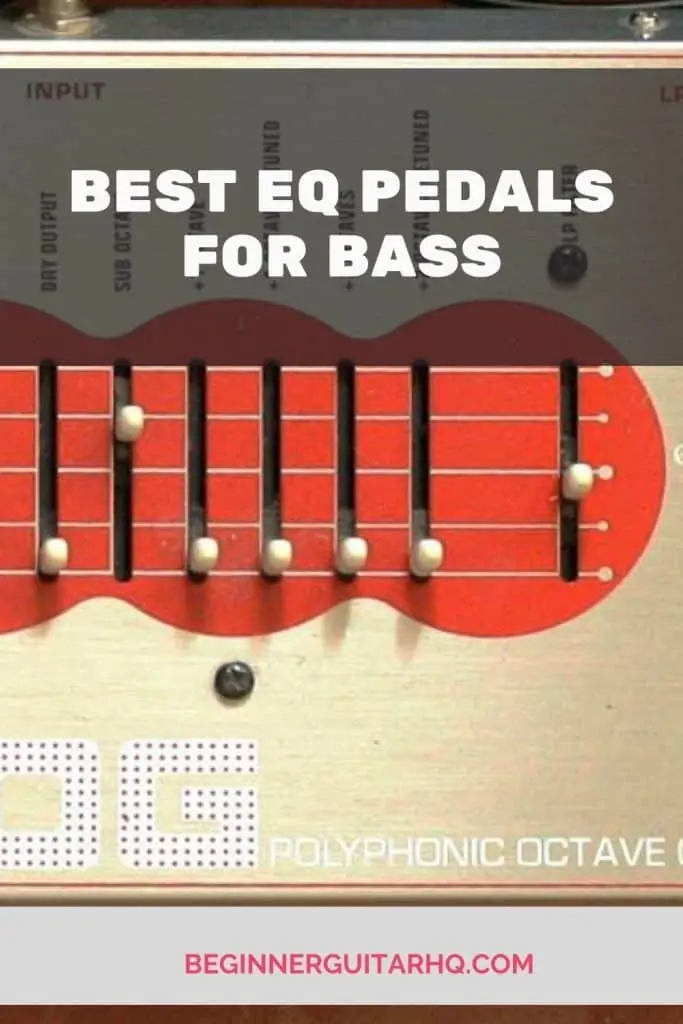Today’s article is detailing the best EQ pedals you can buy for bass guitars. The best EQ pedals can rectify your tone, take care of your instrument’s downsides, and enhance what’s already there.
EQ pedals can make a guitar or a bass guitar shine through a mix and claim its price as the primary sound signature of any song.
Alongside compressor pedals, EQs are the most common tools for mastering and mixing. Whereas EQ tends to happen within the DAW software, it’s often better to use yourself. That’s because it’s a professional tool that can easily improve your playing experience.
We’ll review the top EQ bass pedals available in the market. Before, though, we’ll discuss some basic stuff about these stompboxes.
EQ pedals are important tools for both live playing and recording.
Contents
What is an EQ pedal?
An equalizer is a series of filters with the ability to tweak the audio spectrum. In other words, they pack a technology that can reduce or increase low, mid, and high-level frequency sounds.
EQ pedals can craft your sound’s frequency wave by boosting or cutting specific parts of the spectrum. They are often hard to use, but, in essence, they have Low, Mid, and High sliders to work with.
Some of them are quite simple as they offer a single slider. Others are more complex, as they feature three sliders or more for each frequency area. As a result, there’re models with 10 or 12 sliders to shape the sound.
You can go one step further with parametric equalization. It grants full control over the frequency you chose.
Do you need an EQ pedal?
What I’ve said is fine and dandy but, why would you need an EQ pedal if there’re EQ options on most bass amplifiers, let alone your bass guitar?
Well, first of all, a standalone EQ pedal gives you more control over the frequency, much more than most amps offer.
On top of that, they are easier to use and change on the fly. On top of that, you don’t have much opportunity to change it on the fly.
The secondary improvement is the ability to cut and boost frequencies. Built-in EQ systems on amps simply cut down frequencies or raise volumes.
That means EQ pedals allow you to hone the exact sound you one, with easier controls and access.
There’re other pedals with EQ options, life overdrive stompboxes. These are good options as well, and we might consider them on our list. In particular, some drive pedals can enhance the mid or high frequency to boost the solo sounds.
Still, EQ pedals offer the most options and the best quality systems for the job. They are versatile, easy to understand, and highly recommended for professional musicians.
“Boboroshi’s pedalboard, 2006-01-29, New” by John Athayde, CC BY 2.0 EQ pedals should be a part of every professional pedal setup.
Bass EQ pedals buyer’s guide
If you’re about to pick a bass equalizer pedal, here’re the features you should consider.
Low-frequency controls
One of the critical features is the frequency range controllers. A bass EQ needs to enhance the low-end sounds, the bass. A product that focuses on low frequencies is best for bass guitars.
Make sure you buy an EQ pedal with a frequency range under 100 Hz. The range should go as low as 50 Hz or 50 Hz.
It’s good to have sliders for mid and high frequencies. However, it depends on your playstyle. For example, if you like to play bass solos, high-pitched fills, or slap, you’d want to have mid and treble controls as well.
Either way, you should have enough support on the mids and treble.
Graphic EQ and parametric EQ
There’re two kinds of bass EQ pedals, graphic and parametric.
Parametric EQ models are complex and wide. They grant full control of your instrument’s tone with all of the detail you would ever need. I can recommend it for intermediate and expert players.
Then, the Graphic EQ is the best choice for beginners looking to buy one of these pedals for the first time. These are simple and have a universal interface that’s compatible with various instruments.
There’s a third kind, semi-parametric EQ. These have the typical bass, mid, and treble adjustment knobs.
<iframe width=”956″ height=”538″ src=”https://www.youtube.com/embed/y0P_Lr4sk3c” title=”YouTube video player” frameborder=”0″ allow=”accelerometer; autoplay; clipboard-write; encrypted-media; gyroscope; picture-in-picture” allowfullscreen></iframe>
How to use an EQ pedal?
Equalizer pedals can be as complex as the number of knobs they have. Don’t be afraid, though: they are a relatively simple gear.
First off, remember low notes equal mid frequencies. The fundamental frequencies of bass go between 40 Hz and 1 kHz. Additional overtones and harmonic tones can extend towards 5Khz. There’s not much use beyond that mark.
That said, low frequencies range between 40 Hz and 100 Hz. Most basses can’t go as low as 40 Hz, so a 60 Hz mark is a more common standard.
Naturally, everything above 1 kHz is high-frequency. Everything in-between is a mid-frequency.
EQ pedals have values like -12 and +12 on particular frequency ranges. This means you can raise the volume or cut the volume of that frequency.
In theory, you’ll need to move the low-frequency sliders towards the higher value to raise your bass sounds. Otherwise, you can slide it down to reduce the signal.
It’s that simple, but you have to take your time to get it right for the first time. Also, work with the natural strengths and disadvantages of your bass. For example, if it’s too thin on the low end, raise the low-end bars.
Key frequency bass ranges
Let me help you further with a range cheat sheet. I’ll try to give you an idea on how a bass guitar frequency range sounds.
- LOW END – 20 – 80 Hz: boosting these sounds takes your bass towards the metal-core factory. It’s as deep as it gets. 5-string bass guitars (and 6-string models) can often go very low. Alternatively, you can cut these frequencies to tame the depth of deep bass.
- LOW – 80 – 200 Hz: boosting these frequencies adds depth to your body. It creates a robust and fat sound. If you lower this setting, you can get a smoother, rounder sound.
- LOW MID – 200 – 300Hz: raising these frequencies muddies your sound. It adds crunch, acid, and grit. Otherwise, you can lower this frequency to add articulation.
- MID – 500 – 1000 Hz: here’s where the “punch” lives. If you need more grind, try raising this frequency. Lowering this frequency makes the sound less “bitey.”
- HIGHS – 1 – 5 kHz: here’s where the “attack” lives. Boosting the frequency will add more bite in the upper harmonics and overtones. Lowering the frequency keeps the sound contained on the lows.
There’re no perfect settings and one-fit-all-solution. It’s all about trial and error. You’ll have to tinker with your pedal, your bass, and your amp.
However, if you have a pedal, I recommend leaving your bass and amplifier settings in neutral positions (at the middle). You’ll take care of the EQ solely on the pedal.
As a general rule of thumb, you’ll want to boost the bass. It’s the best way to make your instrument more present in the mix. Enhancing the mids and the treble often makes your bass disappear.
Still, focusing on the mids and low-mids makes your bass sound bluesy or hard-rock. Cutting off the mid makes it sound distorted.
Additionally, treble frequencies gain clarity when you boost them. If you reduce this section, it reduces clarity.
Let’s finish this section with a video tutorial on how to equalize a bass guitar:
<iframe width=”956″ height=”538″ src=”https://www.youtube.com/embed/LIE2co7K0J4″ title=”YouTube video player” frameborder=”0″ allow=”accelerometer; autoplay; clipboard-write; encrypted-media; gyroscope; picture-in-picture” allowfullscreen></iframe>
Top 8 best bass guitar EQ pedals
After reviewing many quality EQ pedals, we have found top-tier alternatives.
A great EQ pedal can make your tone shine either live or through the mix. It’s a professional tool you should consider. As I said, bass guitar priorities should be a compressor and an equalizer.
Best overall: MXR 10-band M180S
<iframe width=”1104″ height=”621″ src=”https://www.youtube.com/embed/dgobmdtpauM” title=”YouTube video player” frameborder=”0″ allow=”accelerometer; autoplay; clipboard-write; encrypted-media; gyroscope; picture-in-picture” allowfullscreen></iframe>
The MXR M10(S pedal is the best overall EQ pedal for bass guitar.
First, it packs an outstanding 10-band equalizer with dual output options. There’s also a true bypass switch that guarantees no noise comes out of the pedal, to the rest of the signal chain.
This model offers the highest quality sound and can put your bass skills to the test. As you attempt to harness its power, you might ruin as much as you might greatly increase your sound.
There’re no other option here aside from the 10 sliders. These allow you to cut each frequency by 12db, or raise these frequencies by 12dB.
Additionally, there’re LED lights on each band so you can see the pedal working on even the darkest scenarios.
Best value: Boss 7-band Graphic EQ
The Boss 7-band EQ takes the cake as the best value EQ pedal for both bass and guitars. It’s a mid-tier, portable gem that offers everything you’d desire in terms of size and design.
Apart from its traditional Boss enclosure, it offers 7 sliders to raise or increase particular frequencies. Apart from this, it offers a master volume controller. The pedal allows you to go up or down by 15 dB.
Coming from Boss, you can expect the highest quality and durability. In fact, the GE-7 is made for touring artists, so it’s small, durable, and can fit most pedalboards.
This model can run on batteries, so you can carry it wherever you go.
Most flexible: Boss EQ-200
<iframe width=”1104″ height=”621″ src=”https://www.youtube.com/embed/LqjIw2T4XU4″ title=”YouTube video player” frameborder=”0″ allow=”accelerometer; autoplay; clipboard-write; encrypted-media; gyroscope; picture-in-picture” allowfullscreen></iframe>
The Bos EQ-200 is a graphic equalizer with added functionality. It’s extra features turn it into the most flexible EQ pedal you can buy for bass guitar.
First, this Boss pedal packs 10 bands, meaning 10 sliders. Each band features a +-15 Db adjustment knob.
Then, the pedal can create left and right channels stereo sound, even from mono signals.
Another element of the pedal is its dual channel configuration. It has A and B channels, and you can swap them with a push button. These are two wide-range 10-band EQ channels working through the onboard graphic display.
Speaking of which, the display shows your current EQ curve. You can select signal flows to configure channels to work as stereo, series, or parallel operation. You can go even further by making the 10 bands work in three different ways.
On top of everything I’ve said, the pedal can store 128 presets. You can access these with external footswitches or MIDI keyybpards. There’s also a Micro USB port you can use to update the pedal’s software.
Lastly, the EQ-200 has a 32-bit AD/DA, a 32-bit internal sound processor, plus a 96 kHz sampling rate. As a result, it produces a high resolution sound.
Best for beginners: MXR M109S
<iframe width=”1104″ height=”621″ src=”https://www.youtube.com/embed/ob8ifgvMogs” title=”YouTube video player” frameborder=”0″ allow=”accelerometer; autoplay; clipboard-write; encrypted-media; gyroscope; picture-in-picture” allowfullscreen></iframe>
The MXR M10S is a 6-band EQ pedal. It’s the smaller version of the MXR 10-band mode, and so it boasts the same quality with fewer options.
It’s six slides makes it the ideal choice for beginners. As EQ pedals are tough to manage, starting with a simpler one might be a good idea.
Either way, the M109S uses a high-quality circuitry, and a lightweight aluminum case. Overall, it delivers plenty of quality, durability, and reliability.
Lastly, the M109S has a true bypass switch plus a low noise nevel.
Best premium: Empress Effects ParaEQ
<iframe width=”1104″ height=”621″ src=”https://www.youtube.com/embed/hsVl-0VI5Z4″ title=”YouTube video player” frameborder=”0″ allow=”accelerometer; autoplay; clipboard-write; encrypted-media; gyroscope; picture-in-picture” allowfullscreen></iframe>
The first parametric EQ to be part of our list is the Empress ParaEQ. Still, it’s a highly complex pedal and delivers plenty of options.
First off, it brings the “basic” low, mid, and high knobs. Aside from its 3-band EQ, it delivers plenty of other options.
First off, it has a boost button that offers 30 dB of clean extra volume. Similarly, it offers true bypass to eliminate noises coming in and out the pedal.
On top of the pedal, there’s a 3-way pad switch. It reduces the volume to 01 -12, and -4 dB. Similarly, you switch the voltage from 9 to 12 and 18V. The higher the power supply, the higher headroom it has.
Within the EQ section, there’s the option to cut or boost each frequency by 15 dB. Additionally, each band can work with 3 different Q settings (wide Q, narrow Q, and medium Q). These modes affect the resonance of the boost or the cut.
On top of that, each band also features a sweepable centre frequency. These work through the “lf,” “mf,” and “hf” knobs, which you can use to select the part of the frequency the pedal is affecting. So, for example, if you’re working with a bass, you’d want your “hf” knob to be around the 1 Khz.
Best budget: Caline CP-24
<iframe width=”1104″ height=”621″ src=”https://www.youtube.com/embed/xmhU2OlcM1A” title=”YouTube video player” frameborder=”0″ allow=”accelerometer; autoplay; clipboard-write; encrypted-media; gyroscope; picture-in-picture” allowfullscreen></iframe>
The Caline CP-24 is a dirt-cheap 10-band EQ pedal for bass and electric guitar. It stands not only because of its low price, but also for its features.
First off, the model features 10 sliders, with the option of reducing or boosting each frequency by 12 dB.
Then, it has a true bypass, which is a rare feature to find at this price range. It keeps the tonal loss minimal.
Lastly, it comes with a durable aluminum carcass. Its price point shouldn’t allow aluminum, but plastic instead.
Overall, it’s the best budget EQ pedal you can buy for your bass.
Best digital: Source Audio SA170 Programmable EQ
Our next item is the complex Source Audio SA170. It’s a programmable digital graphic EQ that can save and recall EQ presets.
This pedal works entirely through a display of sorts. You use buttons to dial up your preferred settings, and then save these settings to use at any time.
Right out of the box, the pedal has 4 slots to save your EQ settings in an easy manner. To do that, you have 8 bands to play with, all of which boasting a -+ adjustable control.
Seven bands show up at once. The eight band is the 62 Hz frequency range, and you can access it at the Octave Extend function. This is a benefit for bass guitars, which can use this super-low spectrum.
On top of all this, the SA170 offers 1 12 dB transparent boost to your instrument’s signal. Other options include MIDI connectivity, true bypass,
Overall, the pedal sounds amazing and serves as a perfect option for those looking for an easy pedal to use.
Our recommendation: Koogo EQ
The Koogo EQ is a five-band model with a small durable chassis. In fact, it’s the smallest EQ pedal available today.
Aside from its comfortable size, the pedal offers top-class functionality.
This compact stompbox has 5-bands with +-18 dB sliders, plus a master level control. On top of that, you have access to frequency centers.
Another thing the pedal delivers is incredible durability, as it comes with an aluminum alloy case. And with this aluminum case comes a very unique aesthetic.
For its ease of use, price, and compact size, the Koogo EQ is our recommendation.




